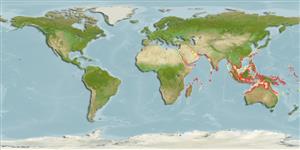>
Acanthuriformes (Surgeonfishes) >
Leiognathidae (Slimys, slipmouths, or ponyfishes) > Gazzinae
Etymology: Karalla: Karalla is the local name for ponyfishes in Sri Lanka and the surrounding region where members of this genus commonly occur.
More on author: Cuvier.
Environment: milieu / climate zone / depth range / distribution range
Ecologia
marinhas demersal; intervalo de profundidade 1 - 40 m (Ref. 3424). Tropical
Indo-West Pacific: Gulf of Aden, along the coasts of India and Sri Lanka; including Pakistan, eastwards to the Philippines (Ref. 4537); probably not reaching Australia.
Tamanho / Peso / Idade
Maturity: Lm ? range ? - ? cm
Max length : 14.0 cm TL macho/indeterminado; (Ref. 3424); common length : 9.0 cm TL macho/indeterminado; (Ref. 3424)
Espinhos dorsais (total) : 8; Raios dorsais moles (total) : 16; Espinhos anais: 3; Raios anais moles: 14 - 15.
Found in shallow waters, predominantly over muddy bottoms (Ref. 30573). Usually occurs in schools. Feeds on polychaetes, bivalves, small crustaceans and sponges (Ref. 30573).
Life cycle and mating behavior
Maturidade | Reprodução | Desova | Ovos | Fecundidade | Larvas
James, P.S.B.R., 1984. Leiognathidae. In W. Fischer and G. Bianchi (eds.) FAO species identification sheets for fishery purposes. Western Indian Ocean (Fishing Area 51). Vol. 2. FAO, Rome. pag. var. (Ref. 3424)
Categoria na Lista Vermelha da IUCN (Ref. 130435: Version 2024-1)
Ameaça para o homem
Harmless
Utilização humana
Pescarias: espécies comerciais
Ferramentas
Relatórios especiais
Descarregue XML
Fontes da internet
Estimates based on models
Preferred temperature (Ref.
123201): 25.3 - 29.2, mean 28.3 °C (based on 1130 cells).
Phylogenetic diversity index (Ref.
82804): PD
50 = 0.7500 [Uniqueness, from 0.5 = low to 2.0 = high].
Bayesian length-weight: a=0.02512 (0.01311 - 0.04811), b=3.00 (2.84 - 3.16), in cm total length, based on LWR estimates for this species & (Sub)family-body (Ref.
93245).
Nível Trófico (Ref.
69278): 3.0 ±0.36 se; based on food items.
Generation time: 0.9 ( na - na) years. Estimated as median ln(3)/K based on 2
growth studies.
Resiliência (Ref.
120179): Elevada, tempo mínimo de duplicação da população menor que 15 meses (Preliminary K or Fecundity.).
Fishing Vulnerability (Ref.
59153): Low vulnerability (11 of 100).
